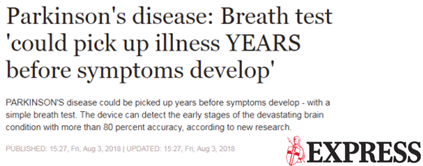
Developments in breath testing for the detection of Parkinson’s
The takeaway
Why is it important?
%
IMPACT
- Novelty 80%
- Proximity 60%
- Deliverability 70%
Impact Opinion
“This is very exciting technology. The early detection of Parkinson’s is not only important from the stand point of treating the people affected by the condition, but also for the research community. A diagnostic aid like a breath analysis device could be extremely informative, telling us a great deal about the early stages of the condition. In addition, it will be interesting to see if this technology can be used to monitor Parkinson’s over time – picking up fluctuations in the condition in a longitudinal study. Such a tool would be of tremendous value, particularly in the context of a clinical trial.”
Background
Using nanomaterial sensors paired with a computer algorithm, in a novel device designed to analyse the volatolome, these researchers had previously been able to discriminate with reasonable accuracy between people with Parkinson’s and controls. However, as the Parkinson’s group were treated with medication in that study, one of the criticisms was that the sensor may have been picking up particles related to the medications themselves. This would limit the scope and utility of such a sensor. So, the Israel based group sought to take this work a step further, and focus on as yet untreated individuals.
The details
Although no single volatile organic particle stood out as clearly different between the two groups, the overall composition of exhaled breath discriminated between the groups with an accuracy of 81%, detecting Parkinson’s at a rate of 79% and correctly identifying controls at a rate of 84%.
How does the method compare to other existing tests? The breath sensory array performed worse than brain imaging focusing on the midbrain which has an accuracy of 92%, but marginally better than the UPSIT smell test which accurately detects Parkinson’s at a rate of 62%, distinguishes controls at 89% and has an overall accuracy of 73%. The researchers point out that a compound called benzaldehyde was higher in the Parkinson’s group (although this was not quite statistically significant), while another, acetophenone appeared to be lowered, paralleling a pattern seen in people with multiple sclerosis.



